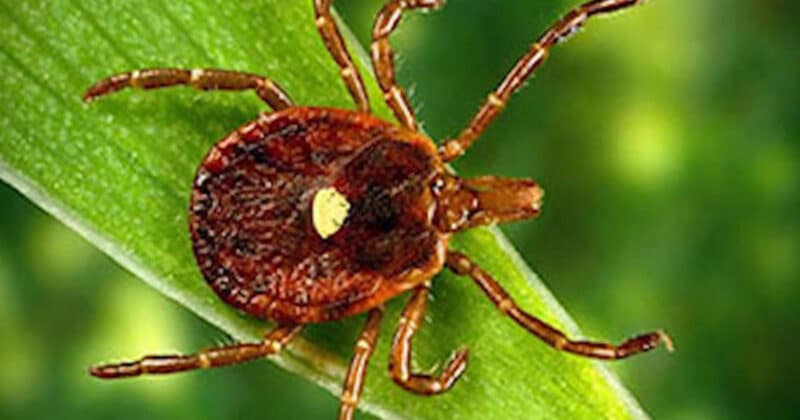by Dr. Sarah Treanor Bois
Director of Research & Education at the Linda Loring Nature Foundation
Lone star ticks have been making a lot of headlines in the northeast recently. Historically from south-eastern, south-central, and mid-Atlantic states, their distribution has been expanding. Lone Star ticks can now be found as far west as Colorado and Wyoming and as far north as Maine. They now co-occur with blacklegged ticks in coastal Massachusetts, including Cape Cod and the islands of Nantucket, Tuckernuck, Martha’s Vineyard, Naushon, and Cuttyhunk.
Lone Star ticks (Amblyomma americanum) are notable for the distinctive white dot on their reddish-brown body which is actually only found on adult females. The adult males have white dots or streaks on the outer edges of their bodies. Nymphs are smaller and distinguished by reddish-brown bodies and fast speed. When I saw them on a sampling sheet during some recent field research, they seemed to streak along compared to the relatively slow black-legged ticks.
Lone Star ticks have similar life stages as the more familiar black-legged ticks —larva, nymph, and adult—but they are able to complete their life cycle in one year instead of two or more. Lone Star ticks are known to be more aggressive than other ticks. Their bite is said to hurt because they have longer mandibles, which might make them easier to detect and remove before disease transmission.
The good news is that Lone Star ticks are less likely to carry pathogens than black-legged ticks. Although their infection levels are low in New England, Lone Star ticks can transmit several disease agents and sometimes cause a delayed red meat allergy “alpha-gal syndrome,” which can show up months after a tick bite. Lone Star ticks don’t transmit Lyme’s Disease, but they can carry tularemia, human ehrlichiosis, and STARI (southern tick associated rash illness). There is little known in the medical field about alpha-gal syndrome (AGS) and it is a growing area of research. AGS affects people differently, with symptoms ranging from mild irritation to anaphylactic shock when consuming (or sometimes even smelling) mammalian meat products. Some people, with management over time, have had their allergy go into remission.
Dr. Sam Telford, Department of Infectious Disease and Global Health at Tufts University, has been conducting tick research on-island for more than 30 years. He has found Lone Star ticks sporadically throughout that entire time—a single adult male here and an adult female there. Early on he chalked it up to dispersal via bird, human, or dog from other areas. But a few individuals do not make a population. It wasn’t until recently that more of the life stages of the Lone Star tick lifecycle were documented (more adults and nymphs) and in larger numbers. Although they occur primarily in woods and adjacent areas, Lone Star ticks are found in grassy habitats as well, and their abundance in most habitats can far exceed that of blacklegged ticks. On Fire Island, New York, for example, where Lone Star ticks first established in the 1980s, Lone Star nymphs became about five times more abundant than black-legged nymphs over a period of just three years. Lone Star ticks are now the dominant tick species on Long Island. Dr. Telford thinks Nantucket may be headed in that same direction.
In 2009, Dr. Telford first sampled on Cuttyhunk Island which is when he was astonished to see so many Lone Star ticks. After sampling for several years there, he did find all three life stages. Subsequently, other Elizabethan Islands became infested. Similar to Nantucket, sporadic collections of Lone Stars were found on Martha’s Vineyard. Now, all three life stages have been documented. Lone Stars on MV are now widespread across the island, but recently Aquinnah has had the highest rates. Select Board members there are trying to figure out how to address the problem with some even suggesting burning the edges of yards to reduce tick habitat. Nantucketers will do well to keep an eye on how the Vineyard handles this situation. It seems we aren’t far behind. By 2017, Dr. Telford had found nearby Tuckernuck to be highly infested.
A new study looking at tick prevalence across Nantucket and Tuckernuck is being led by Dr. Allison Snow, Department of Evolution, Ecology, and Organismal Biology, Ohio State University. In her first year of sampling (2020), she found Lone Star ticks abundant on Tuckernuck but rare on Nantucket, with only one adult female and two nymphs detected. This year, however, Dr. Snow reported much higher numbers, indicating the possibility of Lone Star tick population establishment on Nantucket.
In Dr. Snow’s field sampling, she encountered an average of 106 Lone Star nymphs and 35 adults per km of trail on Tuckernuck in 2020. In 2021, she was shocked to find the rates tripled to 332 nymphs and 82 adults per km of trail for the same transects.
On Nantucket, Dr. Snow has three sampling sites in Madaket. Most of these sites weren’t sampled in 2020 and they are still well below the rates on Tuckernuck. There still haven’t been any documented reports of larvae, but it doesn’t seem too far off, given what we now about Lone Star tick populations from other parts of our region. Dr. Snow is planning for at least a third field season (2022) to compare these rates and get a better idea of what might be regular year-toyear variation in tick numbers or what is potentially the beginning of a pattern of increase.
Milder winters, as seen with climate change in our region, are one of the proposed reasons for the increase in ticks generally and thought to be why we are seeing Lone Star ticks now. Not only are the conditions more suitable for the ticks, warmer weather may increase the populations of small rodents, like mice and rats, that ticks use as breeding grounds. It’s not all climate change, however.
There is still a lot that we don’t know about the nuance of tick populations. There are many other factors at play, such as changes in regional precipitation (and increase in humidity) and increased global transport and travel thus creating vectors for tick distribution increase.
On Nantucket, multiple researchers are studying all aspects of ticks: tick biology, species and populations, tick-borne diseases, how to reduce the populations, and how to reduce disease transmission. There may be some overlap but, as with all scientific research, studies build upon each other. We all benefit when there are more researchers studying these issues.
For a great online resource that can answer most tick questions and will even go the extra mile, visit the Tick Encounter Resource Center at tickencounter.org, out of the University of Rhode Island. It offers a plethora of regional tick information based in science and with important information from the CDC. You can also share photos of ticks you find and even find resources for having ticks tested for pathogens.
Prevention is the best treatment. How can you avoid tick bites?
• Avoid known tick habitats: brushy and moist areas (stay on mowed paths and trails)
• Tuck your pants inside your socks to make it easier to see ticks
• Use repellant. There are many options for sprays or inoculated clothing (DEET and permethrin are preferred).
• Regularly check yourself and your family for ticks. Pay close attention to hotspots like armpits, groin, and back.
• Treat your pets with medications or tick collars to repel ticks.
• Support tick research where possible. The more we know, the better prepared we can be.
Don’t forget to enjoy Nantucket! With some preventative measures and a good tick check at the end of the day, you can still enjoy the wonderful nature Nantucket has to offer.



